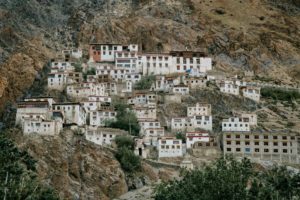Ironically, development and cultural identity does not go hand in hand in Ladakh.
People in Ladakh have been changing with time, unfortunately at the cost of their own identity. Cultural extinction has become the new norm and has certainly replaced cultural integration.

While various measures have been taken to include the Bhoti language (Ladakhi language) in the 8th schedule of the constitution which includes major languages of the country, not many people from Ladakh are interested in promoting the sanctity of the language.
The current wind however signals progress and change for the cultural identity of Ladakh.
The Central government has taken a decision to form a committee for the protection of the language, land, and culture of the Ladakh region. This will be done to redirect and make sure the citizens contribute in the Union Territory’s development.
The committee by the government will be headed by G Kishan Reddy, Union Minister of State for Home Affairs, and will also include elected representatives from the Central government, Ladakh administration, and Ladakh autonomous hill development.
The decision of forming the committee came after Union Home Minister Amit Shah met a 10-member delegation from Ladakh. During the meeting, the delegation expressed their views about the need for protecting the unique cultural identity of the Ladakh region.
Why is it important to save Ladakh’s Culture?
Ladakh has undergone a demographic shift and while changes have been taking place, it is of perennial importance to focus on the geographical element of Ladakh.
Ladakh in the east of India, is perhaps the purest remaining example of traditional Tibetan societies since China’s subjugation of Tibet in the 1950s.
For centuries, Ladakh’s culture was preserved by geographic isolation. But in 1960, the Indian government built a road from the Kashmir valley into Ladakh to defend its borders with China and Pakistan.
In August of 2019, the Indian parliament passed a reorganization act which entailed the provisions for reconstituting Ladakh as a Union Territory.
This step separated Ladakh from Jammu and Kashmir in 2019.
Hence, supporting and accentuating Ladakh’s unique culture and authenticity becomes even more predominant.
In addition to igniting an interest in new products and practices, tourism is effecting a profound change in the Ladakhis’ own-image. Through contact with tourists, the Ladakhis gain the impression that Westerners lead a life of infinite wealth and leisure.
By comparison, their own way of life – a near miracle of social and environmental balance – seems inferior and outdated to them.
What is Ladakh’s Unique Culture?
While speaking to the delegation, Home Minister Amit Shah reiterated the union government’s commitment to preserving Ladakh.
He Confirmed of how under Prime Minister Narendra Modi’s leadership, Ladakh’s land and culture will be protected and developed.
To many of us, who are still oblivious to what Ladakh has to offer on its platter of Culture, here is a quick insight.
The languages spoken in Ladakh are:
- Ladakhi
- Tibetan
- Urdu
- Balti
While, Ladakhi & Tibetan are used by the locals in their everyday life, there is still a diverse group that speaks all or many of the above mentioned.
Ladakhis have a blend of dresses, attires, beauty gears from different communities and tribes.
People from Ladakh wear a thick woollen robe called Goncha (the traditional gown) with accessories such as Tipi (hat), Lokpa (a thick cloak worn by only women that provides extra warmth), Bok, shawl or Tsa-zar for men.
Goncha or Kos or Sulma are the main dress worn by all the communities in Ladakh by both men and women with a colourful sash tied around their waist. The women’s robe, however, flares downwards with small pleats accentuating it into a flowy gown.
Most of the dishes in Ladakh are prepared from the local produce which consists of pumpkins, beans, potatoes, beetroot & barley. Rice mutton & chicken dishes are also prepared along with yak meat, but this is mostly limited to the winter season.
The influence of Tibetan culture is also visible in the most famous dishes of Ladakh, which are thenthuk, skyu, momo and thukpa. Gur gur cha and cha ngarmo are also widely enjoyed by the people, as is the local alcohol called chhang.
The folk music of Ladakh, which is heavily influenced by Tibetan music, involves religious chanting. These chants are holy narrations of sacred texts.
While the cultural blend is magnanimous, there is one thing that needs even great attention. The youth of Ladakh needs to be uplifted through the advent of promising job opportunities.
Located on a very high altitude, the region faces very harsh cold weather throughout the year and poses difficulty in the growth of agriculture and establishment of industries in the region. This prohibits the scope for a multitude of jobs which shall be a set of things the government needs to chalk out in its roadmap.
The high altitude Union Territory is also known as the “Land of Passes” traversed with extremely high Himalayan mountain ranges and narrow passes.
Many important rivers and tributaries also trace their path to this region including Indus and its tributaries namely the Shyok, Nubra, Zanskar among others.
The delegation has also requested the Home Minister to bring development opportunities for the residents of the UT and increase employment for the youth of the region.
The recent round of talks is a ray of shining hope for the people of Ladakh, provided they work towards making the action plan a ground success.

